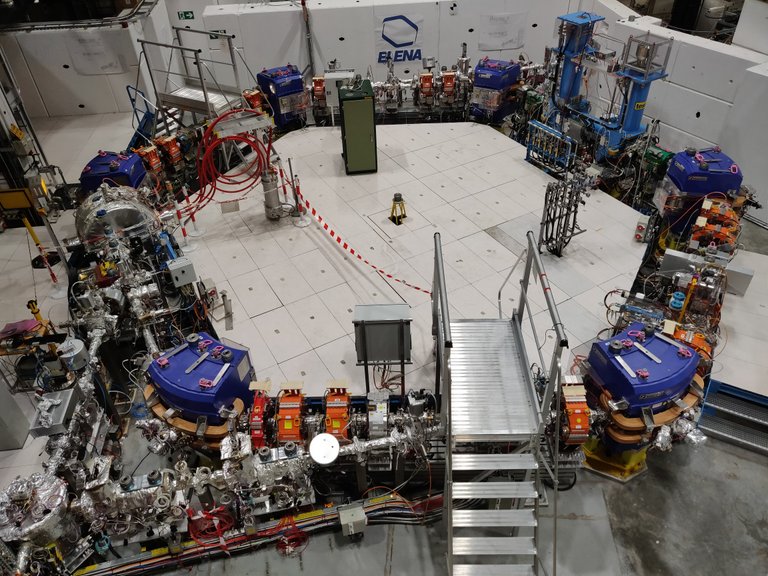In Part 2 of this series investigating the Antimatter Factory at CERN and its research to the general public, we discussed antimatter's applications and why it is studied. Read the post here: https://steemit.com/steemstem/@cgrech/the-antimatter-factory-part-2-why-do-we-investigate-antimatter
In this post, we will discuss the manner by which antiprotons are produced, specifically at the Antimatter Factory.

Low energy physics
In the world of antimatter physics research, antimatter particles are investigated when they are almost stationary, and hence all equipment aims to slow down these particles so that they can be trapped. Whereas CERN is known for ever-increasing particle energy collisions and high luminosity experiments, in this building, the particle physics aims are opposite, as researchers deal with creating antiprotons and decelerating them down as much as possible. Hence, the two synchrotrons in the Antimatter Factor (the Antiproton Decelerator (AD) and the Extra Low ENergy Antiproton (ELENA) ring) are technically particle decelerators, and not particle accelerators [1].
The concept behind the synchrotron remains the same as any particle accelerator, with the addition of an element called an electron cooler, which reduces the momentum spread of the particles.
Creating antiprotons and the AD decelerator
Antimatter researchers perform experiments on antihydrogen made up of one antiproton and one positron, the latter obtained from a sodium isotope. Antiprotons, on the other hand, are produced by firing protons towards a metal block target. At CERN, as can be seen below, protons are obtained from the Proton Synchrotron (which is part of the Large Hadron Collider injector chain) and headed towards a metal block close to the AD ring.
The energy from the collisions is enough to create a new proton-antiproton pair about once in every million collisions, making it a quite inefficient procedure, and the main reason behind the very low amounts of antimatter manufactured. The antiprotons produced travel at almost the speed of light and have too much energy to be useful for making antiatoms. They also have a range of energies and move randomly in all directions. The job of the AD is to tame these unruly particles into a useful low-energy beam.
A ring of bending and focusing magnets keeps the antiprotons on the same track, while strong electric fields slow them down. Passing the antiprotons through clouds of electrons – a technique known as “cooling” – reduces the sideways motion and the spread in energies. Finally, when the antiprotons have slowed down to about 10% of the speed of light, they are ready to be ejected and sent to the six experiments [2-4].
The ELENA ring
The ELENA (Extra Low ENergy Antiproton) deceleration ring was built in 2016 and has been undergoing commissioning up until CERN's long shutdown which started in December 2018. Coupled with the AD, this small ring with a circumference of 30 m slows the antiprotons down even further, reducing their energy by a factor of 50, from 5.3 MeV to just 0.1 MeV. The experiments will be able to trap 10 to 100 times more antiprotons, improving efficiency and paving the way for new studies [5].
The ring can be admired by the public visiting the Antimatter Factory as can be seen in the picture below. The ring has six bending dipole magnets (blue magnets in the corner), and several quadrupole magnets (in orange), a Radio-Frequency cavities which controls the speed of the particles (on the left) and the electron cooler (u-shaped equipment). This ring is already providing antiprotons to the GBAR experiment, which is investigating the effect of gravity on antihydrogen particles. The next post will discuss this experiment with more details on the equipment and methodology.

Up next: GBAR experiment
References:
[1] https://angelsanddemons.web.cern.ch/antimatter/making-antimatter
[2] Michal Dudek -- CERN ELENA part 1
[3] Michal Dudek -- CERN ELENA part 2
[4] Michal Dudek -- CERN ELENA part 3
[5] https://home.cern/science/accelerators/antiproton-decelerator

This post has been voted on by the SteemSTEM curation team and voting trail.
If you appreciate the work we are doing then consider voting us for witness by selecting stem.witness!
For additional information please join us on the SteemSTEM discord and to get to know the rest of the community!
Needs citations
Added! Thanks for the observation.
Thanks :)
Congratulations @cgrech! You have completed the following achievement on the Steem blockchain and have been rewarded with new badge(s) :
Click here to view your Board
If you no longer want to receive notifications, reply to this comment with the word
STOP